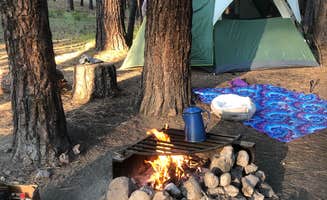Tent camping near Wrangell, Alaska requires navigating the distinct challenges of the Tongass National Forest ecosystem. Located in Alaska's southeastern panhandle, Wrangell campsites typically sit at low elevations between 50-300 feet above sea level, allowing easier access but greater exposure to coastal weather patterns. Summer temperatures generally range from 45-65°F with rainfall averaging 82 inches annually, concentrated in September through November.
What to do
Wildlife viewing opportunities: At Three Sisters Overlook Campsite, campers can observe various Alaskan wildlife in their natural habitat. The site serves as an excellent base for day hikes along unmarked forest trails that provide glimpses of black bears, Sitka black-tailed deer, and various bird species.
Fishing excursions: Salamander Creek areas offer productive fishing spots within walking distance of campsites. The streams contain seasonal runs of pink and chum salmon (July-September), with Dolly Varden trout present year-round. Alaska fishing licenses required and available in Wrangell for $25/day or $70/week for non-residents.
Photography expeditions: Turn Island Beach Campsite provides unique vantage points for capturing coastal landscapes. The shifting tidal patterns create constantly changing scenery, with morning fog often creating atmospheric conditions popular with photographers. Tripods recommended due to frequent low light conditions.
What campers like
Privacy between sites: Highline Campsite features natural vegetation buffers between camping areas. The spacing between sites allows for private experiences despite the small camping area, with natural forest undergrowth creating natural boundaries between camping spots.
Marine wildlife sightings: Coastal campsites provide opportunities to spot marine mammals from shore. During summer months, harbor seals, sea lions, and occasional orcas can be viewed from Anita Bay Overlook Campsite, particularly during morning hours when water is typically calmer.
Minimal light pollution: The remote nature of these campgrounds creates exceptional stargazing conditions on clear nights. The lack of nearby development means virtually no artificial light, allowing for superior astronomical viewing when clouds permit, typically best during April and May when nights remain dark enough but weather improves.
What you should know
Water access challenges: Most campsites require water filtration from natural sources. Campers should bring filtration systems capable of handling sediment and bacteria. Streams may run high or become silty after rainfall, necessitating collection from multiple locations.
Communication limitations: Cell service is non-existent at most sites. Lower Salamander Creek Campground and other remote locations have zero connectivity, requiring satellite phones for emergency communication. The nearest reliable cell signal is in Wrangell proper.
Bear safety protocols: All food must be stored using bear-resistant containers or proper hanging techniques at least 100 feet from sleeping areas. The Forest Service recommends carrying bear spray and making noise while hiking between May and October when bears are most active.
Tips for camping with families
Best age-appropriate sites: Younger children typically do better at sites closer to Wrangell with shorter hiking requirements. For families with children under 10, Yunshookuh Loop Campground offers more level terrain and shorter distances between features.
Weather preparedness: Pack multiple changes of clothes for children and waterproof storage options. The frequent precipitation means kids will likely get wet during normal play activities, with rapid temperature drops possible even in summer months.
Activity planning: Bring compact, packable activities for periods of heavy rain. Card games, field guides for wildlife identification, and waterproof journals provide entertainment during the frequent weather delays that can occur throughout the camping season.
Tips from RVers
Limited vehicle access: Most tent campsites near Wrangell cannot accommodate recreational vehicles of any size. RVs must remain at established roads, with tent camping requiring hiking the final distances to sites.
Alternative options: RV campers can base at Wrangell's limited in-town parking areas (permits required from city hall) and use water taxi services to access the remote tent sites for day visits. Costs typically range from $150-300 round-trip depending on distance.
Supply considerations: No dump stations or hookups exist near primitive camping areas. RVers planning tent excursions should prepare for completely self-sufficient camping with all supplies carried in backpacks from vehicle parking locations.


